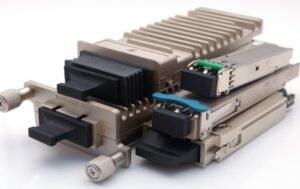Optical fibers, made from glass or plastic, serve as efficient tools for transmitting light using the principle of total internal reflection. Encased in a flexible plastic sheath, these fibers can bend without breaking, offering a robust solution for information transmission. This article explores the working principles, types, and applications of optical fibers, shedding light on their significant role in modern communication.
Working Principle
Optical fibers operate on the principle of total internal reflection, ensuring minimal signal loss during transmission. At one end, a light-emitting device, such as a light-emitting diode or laser, sends light pulses into the fiber, while a light-sensitive component at the other end detects these pulses.
Advantages of Fiber Optics
- Immense Communication Capacity: Theoretically, a single fiber can transmit up to 10 billion voice channels simultaneously, surpassing traditional coaxial cables and microwaves by several orders of magnitude.
- Extended Relay Distances: With an extremely low attenuation coefficient, fiber optics can relay signals over distances of thousands of kilometers. This far exceeds the capabilities of traditional cables and microwaves.
- Exceptional Security: As the fundamental component is quartz, which does not conduct electricity, fiber optics are impervious to electromagnetic interference, providing enhanced security against eavesdropping.
- Versatility: Fiber optics resist external electromagnetic and industrial interference, making them highly adaptable in various environments.
- Compact and Lightweight: The small size and light weight of fiber optic cables make them easy to handle and install.
- Abundant and Affordable Raw Materials: Silica, the main ingredient in fiber optics, is abundant and inexpensive, contributing to the cost-effectiveness of this technology.
Types of Fiber Optics
- Multimode Fiber: Capable of transmitting multiple modes of light but suffers from significant modal dispersion, limiting its use for high-frequency digital signals, especially over long distances.
- Single-Mode Fiber: Designed to transmit only one mode of light, minimizing modal dispersion and making it suitable for long-distance communication.
Dispersion in Optical Fibers
Causes of Dispersion
In optical fibers, light signals consist of various components. Due to different propagation speeds of signal frequency components or mode components, a delay difference occurs among these components after transmitting a certain distance through the optical fiber. This phenomenon, known as optical fiber dispersion, leads to distortion of the transmission signal waveform and broadening of pulses.
Effects of Dispersion
The presence of optical fiber dispersion causes distortion and broadening of transmitted signal pulses, resulting in inter-symbol interference. To ensure communication quality, it is necessary to increase the spacing between symbols, i.e., reduce the signal transmission rate, limiting the communication capacity and transmission distance of the optical fiber system.
Types of Dispersion
Optical fiber dispersion can be classified into modal dispersion, material dispersion, waveguide dispersion, and polarization dispersion based on the reasons for its occurrence.
Types of Loss
- Absorption Loss(Intrinsic Absorption: Inherent absorption of the optical fiber material itself; Impurity Absorption: Absorption of light by impurities in the optical fiber.)
- Scattering Loss
- Linear Scattering
- Nonlinear Scattering
- Imperfect Structure Scattering
- Other Losses
- Microbend Loss
When the optical fiber is bent, light transmission may change from a transmission mode to a radiation mode, causing some light to penetrate into the cladding or leak out through the cladding, resulting in loss. When the bending radius is greater than 5-10 cm, losses caused by bending can be neglected.
Single-mode Fiber vs. Multimode Fiber
In the realm of fiber optics, the choice between single-mode fiber (SMF) and multimode fiber (MMF) is a critical consideration, each offering unique characteristics suited for specific applications.
| MMF | SMF | |
|---|---|---|
| Fiber Optic Cost | Expensive | Not too expensive |
| Transmission Device | Basic, low cost | More expensive (laser diode) |
| Attenuation | High | Low |
| Transmission Wavelength | 850nm to 1300nm | 1260nm to 1650nm |
| Operate | Larger core diameter for easier handling | Connections are more complex |
| Distance | Local network (<2km) | Access network/medium distance/long distance network (>200km) |
| Bandwidth | Limited bandwidth | Virtually unlimited bandwidth |
| In Conclusion | Fiber optics are more expensive, but network activation alone is relatively inexpensive | Provides higher performance, but expensive to set up network |
Applications of Multimode Fiber (MMF) and Single-mode Fiber (SMF)
In accordance with ITU-T recommendations, communication fibers are classified into seven categories (G.651-G.657), with G.651 as multimode and G.652 to G.657 as single-mode fibers.
| ITU Standard | Fiber Optic Type | Name | Applications |
|---|---|---|---|
| G.651 | Multimode | Bending-resistant optical fiber | Suitable for short-distance transmission of optical wavelengths 850nm/1310nm (Ethernet, LAN) |
| G.652 | Single-mode | Dispersive non-shifted single-mode fiber | Suitable for light wavelengths of 1310nm-1550nm (access network), conventional single-mode optical fiber. Suitable for fiber-to-the-home, long-distance, and metropolitan area networks. |
| G.653 | Single-mode | Dispersion-shifted fiber | Suitable for long-distance transmission (backbone network, submarine optical cable) with a wavelength of 1550nm, and will soon disappear from the stage of history |
| G.654 | Single-mode | Cut-off wavelength shifted fiber | Suitable for long-distance transmission with optical wavelength of 1550nm (submarine optical cable, not supporting DWDM), 5G bearer network |
| G.655 | Single-mode | Non-zero dispersion shifted fiber | Suitable for long-distance transmission of light with a wavelength of 1550nm (backbone network, submarine optical cable, supporting DWDM), later or only for long-distance line maintenance |
| G.656 | Single-mode | Low slope non-zero dispersion shifted fiber | A type of non-zero dispersion shifted fiber, it has strict requirements on the speed of dispersion, ensuring transmission performance within a larger wavelength range in DWDM systems, and has a low possibility of mass production. |
| G.657 | Single-mode | Bending resistant optical fiber | New products based on the needs and assembly applications of FTTx technology. G.657 fiber is the latest fiber variety developed based on G.652 fiber in order to achieve the goal of fiber-to-the-home. It is more suitable for FTTH information transmission and suitable for installation in narrow places such as indoors or buildings. |
Conclusion
Aerech Networks recognizes the pivotal role that fiber optics play in shaping the future of communication. With its vast capacity, extended reach, and robust security features, fiber optics continue to be at the forefront of technological advancements. As we embrace the era of high-speed, reliable communication, Aerech Networks remains committed to harnessing the power of fiber optics for a connected world.



